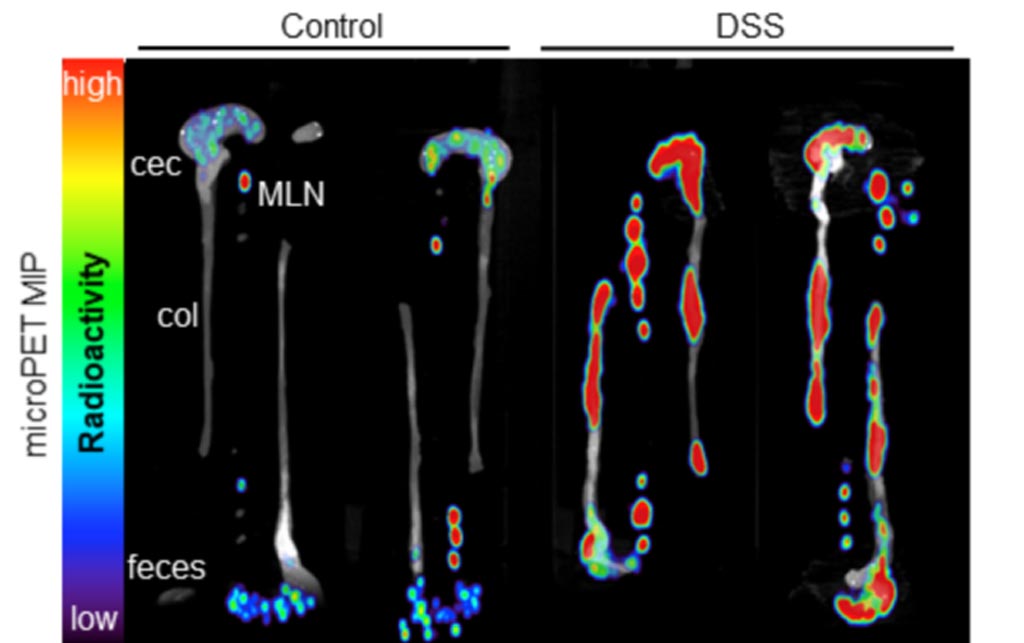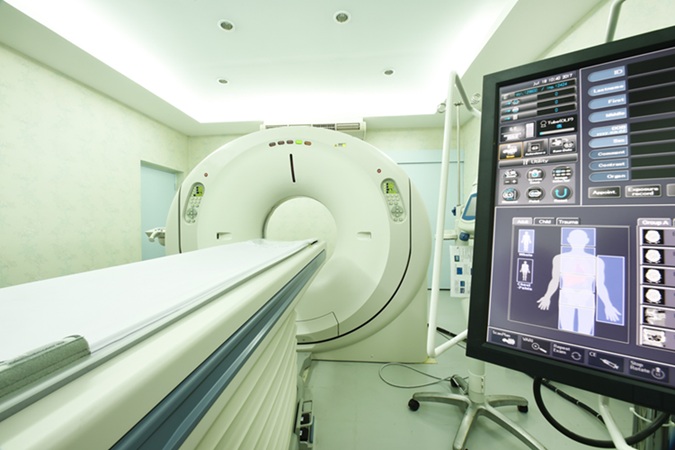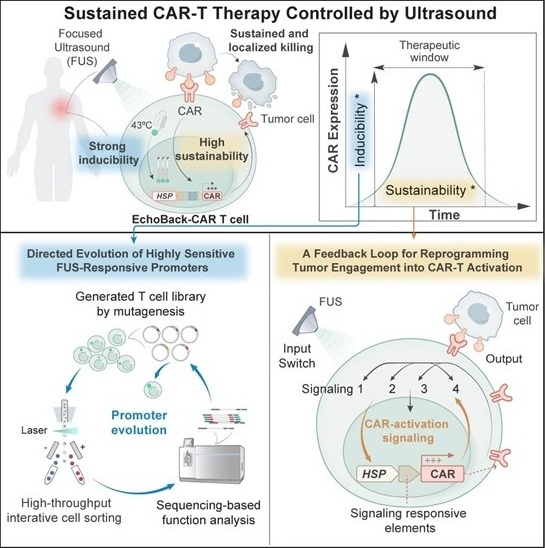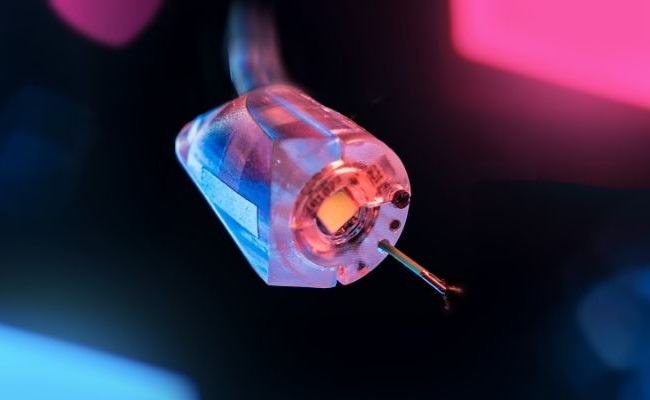PET Imaging Technique Pinpoints Colitis Inflammation
|
By MedImaging International staff writers Posted on 13 Jun 2018 |

Image: Ex vivo images of colons, ceca, and mesenteric lymph nodes taken via the immunoPET platform (Photo courtesy of UCLA).
A new positron emission tomography (PET) method can detect inflammation sites in people with inflammatory bowel disease (IBD), according to a new study.
Researchers at the University of California, Los Angeles (UCLA; USA) and Regeneron Pharmaceuticals (Tarrytown, NY, USA) conducted a mouse model study of colitis that used PET imaging with antibody fragment probes (immunoPET) based on GK1.5 cys-diabody (cDb) that target CD4+ T cells, a subset of immune cells characteristic of IBD. A zirconium-89 (89Zr)-labeled anti-CD4 engineered cDb probe was used for noninvasive imaging of the distribution of CD4+ T cells in mice with induced colitis.
The results revealed an increased number of CD4+ T cells in the colons of colitic mice, as confirmed by immunohistochemistry. Increased uptake of 89Zr-malDFO-GK1.5 cDb was detected in the distal colon, ceca, and mesenteric lymph nodes (MLNs) in in-vivo PET scans. Ex-vivo scans and biodistribution also confirmed the higher uptake in dextran sulfate sodium (DSS)-treated colons, ceca, and MLN. The researchers suggest that CD4 immunoPET has the potential to guide development of antibody-based imaging in humans with IBD. The study was published in the June 2018 issue of The Journal of Nuclear Medicine.
“ImmunoPET is a robust and general platform for visualization of highly specific molecular targets. CD4 immunoPET could provide a noninvasive means to detect and localize sites of inflammation in the bowel and also provide image guidance for biopsies,” said senior author Professor Anna Wu, PhD, director of the UCLA cancer molecular imaging program. “It could unlock our ability to assess inflammation in a broad spectrum of disease areas, including oncology and immune-oncology, auto-immunity, cardiovascular disease, neuroinflammation, and more.”
CD4+ T helper cells are white blood cells that are an essential part of the human immune system. They are called helper cells because one of their main roles is to send signals to other types of immune cells, including CD8 killer cells, which then destroy the infectious particle. If CD4 cells become depleted, for example in untreated HIV infection, or following immune suppression prior to a transplant, the body is left vulnerable to a wide range of infections that it would otherwise have been able to fight.
Related Links:
University of California, Los Angeles
Regeneron Pharmaceuticals
Researchers at the University of California, Los Angeles (UCLA; USA) and Regeneron Pharmaceuticals (Tarrytown, NY, USA) conducted a mouse model study of colitis that used PET imaging with antibody fragment probes (immunoPET) based on GK1.5 cys-diabody (cDb) that target CD4+ T cells, a subset of immune cells characteristic of IBD. A zirconium-89 (89Zr)-labeled anti-CD4 engineered cDb probe was used for noninvasive imaging of the distribution of CD4+ T cells in mice with induced colitis.
The results revealed an increased number of CD4+ T cells in the colons of colitic mice, as confirmed by immunohistochemistry. Increased uptake of 89Zr-malDFO-GK1.5 cDb was detected in the distal colon, ceca, and mesenteric lymph nodes (MLNs) in in-vivo PET scans. Ex-vivo scans and biodistribution also confirmed the higher uptake in dextran sulfate sodium (DSS)-treated colons, ceca, and MLN. The researchers suggest that CD4 immunoPET has the potential to guide development of antibody-based imaging in humans with IBD. The study was published in the June 2018 issue of The Journal of Nuclear Medicine.
“ImmunoPET is a robust and general platform for visualization of highly specific molecular targets. CD4 immunoPET could provide a noninvasive means to detect and localize sites of inflammation in the bowel and also provide image guidance for biopsies,” said senior author Professor Anna Wu, PhD, director of the UCLA cancer molecular imaging program. “It could unlock our ability to assess inflammation in a broad spectrum of disease areas, including oncology and immune-oncology, auto-immunity, cardiovascular disease, neuroinflammation, and more.”
CD4+ T helper cells are white blood cells that are an essential part of the human immune system. They are called helper cells because one of their main roles is to send signals to other types of immune cells, including CD8 killer cells, which then destroy the infectious particle. If CD4 cells become depleted, for example in untreated HIV infection, or following immune suppression prior to a transplant, the body is left vulnerable to a wide range of infections that it would otherwise have been able to fight.
Related Links:
University of California, Los Angeles
Regeneron Pharmaceuticals
Latest General/Advanced Imaging News
- AI-Powered Imaging System Improves Lung Cancer Diagnosis
- AI Model Significantly Enhances Low-Dose CT Capabilities
- Ultra-Low Dose CT Aids Pneumonia Diagnosis in Immunocompromised Patients
- AI Reduces CT Lung Cancer Screening Workload by Almost 80%
- Cutting-Edge Technology Combines Light and Sound for Real-Time Stroke Monitoring
- AI System Detects Subtle Changes in Series of Medical Images Over Time
- New CT Scan Technique to Improve Prognosis and Treatments for Head and Neck Cancers
- World’s First Mobile Whole-Body CT Scanner to Provide Diagnostics at POC
- Comprehensive CT Scans Could Identify Atherosclerosis Among Lung Cancer Patients
- AI Improves Detection of Colorectal Cancer on Routine Abdominopelvic CT Scans
- Super-Resolution Technology Enhances Clinical Bone Imaging to Predict Osteoporotic Fracture Risk
- AI-Powered Abdomen Map Enables Early Cancer Detection
- Deep Learning Model Detects Lung Tumors on CT
- AI Predicts Cardiovascular Risk from CT Scans
- Deep Learning Based Algorithms Improve Tumor Detection in PET/CT Scans
- New Technology Provides Coronary Artery Calcification Scoring on Ungated Chest CT Scans
Channels
Radiography
view channel
World's Largest Class Single Crystal Diamond Radiation Detector Opens New Possibilities for Diagnostic Imaging
Diamonds possess ideal physical properties for radiation detection, such as exceptional thermal and chemical stability along with a quick response time. Made of carbon with an atomic number of six, diamonds... Read more
AI-Powered Imaging Technique Shows Promise in Evaluating Patients for PCI
Percutaneous coronary intervention (PCI), also known as coronary angioplasty, is a minimally invasive procedure where small metal tubes called stents are inserted into partially blocked coronary arteries... Read moreMRI
view channel
AI Tool Tracks Effectiveness of Multiple Sclerosis Treatments Using Brain MRI Scans
Multiple sclerosis (MS) is a condition in which the immune system attacks the brain and spinal cord, leading to impairments in movement, sensation, and cognition. Magnetic Resonance Imaging (MRI) markers... Read more
Ultra-Powerful MRI Scans Enable Life-Changing Surgery in Treatment-Resistant Epileptic Patients
Approximately 360,000 individuals in the UK suffer from focal epilepsy, a condition in which seizures spread from one part of the brain. Around a third of these patients experience persistent seizures... Read more
AI-Powered MRI Technology Improves Parkinson’s Diagnoses
Current research shows that the accuracy of diagnosing Parkinson’s disease typically ranges from 55% to 78% within the first five years of assessment. This is partly due to the similarities shared by Parkinson’s... Read more
Biparametric MRI Combined with AI Enhances Detection of Clinically Significant Prostate Cancer
Artificial intelligence (AI) technologies are transforming the way medical images are analyzed, offering unprecedented capabilities in quantitatively extracting features that go beyond traditional visual... Read moreUltrasound
view channel
Novel Imaging Method Enables Early Diagnosis and Treatment Monitoring of Type 2 Diabetes
Type 2 diabetes is recognized as an autoimmune inflammatory disease, where chronic inflammation leads to alterations in pancreatic islet microvasculature, a key factor in β-cell dysfunction.... Read more
Ultrasound-Based Microscopy Technique to Help Diagnose Small Vessel Diseases
Clinical ultrasound, commonly used in pregnancy scans, provides real-time images of body structures. It is one of the most widely used imaging techniques in medicine, but until recently, it had little... Read moreNuclear Medicine
view channel
Novel PET Imaging Approach Offers Never-Before-Seen View of Neuroinflammation
COX-2, an enzyme that plays a key role in brain inflammation, can be significantly upregulated by inflammatory stimuli and neuroexcitation. Researchers suggest that COX-2 density in the brain could serve... Read more
Novel Radiotracer Identifies Biomarker for Triple-Negative Breast Cancer
Triple-negative breast cancer (TNBC), which represents 15-20% of all breast cancer cases, is one of the most aggressive subtypes, with a five-year survival rate of about 40%. Due to its significant heterogeneity... Read moreImaging IT
view channel
New Google Cloud Medical Imaging Suite Makes Imaging Healthcare Data More Accessible
Medical imaging is a critical tool used to diagnose patients, and there are billions of medical images scanned globally each year. Imaging data accounts for about 90% of all healthcare data1 and, until... Read more
Global AI in Medical Diagnostics Market to Be Driven by Demand for Image Recognition in Radiology
The global artificial intelligence (AI) in medical diagnostics market is expanding with early disease detection being one of its key applications and image recognition becoming a compelling consumer proposition... Read moreIndustry News
view channel
GE HealthCare and NVIDIA Collaboration to Reimagine Diagnostic Imaging
GE HealthCare (Chicago, IL, USA) has entered into a collaboration with NVIDIA (Santa Clara, CA, USA), expanding the existing relationship between the two companies to focus on pioneering innovation in... Read more
Patient-Specific 3D-Printed Phantoms Transform CT Imaging
New research has highlighted how anatomically precise, patient-specific 3D-printed phantoms are proving to be scalable, cost-effective, and efficient tools in the development of new CT scan algorithms... Read more
Siemens and Sectra Collaborate on Enhancing Radiology Workflows
Siemens Healthineers (Forchheim, Germany) and Sectra (Linköping, Sweden) have entered into a collaboration aimed at enhancing radiologists' diagnostic capabilities and, in turn, improving patient care... Read more


















